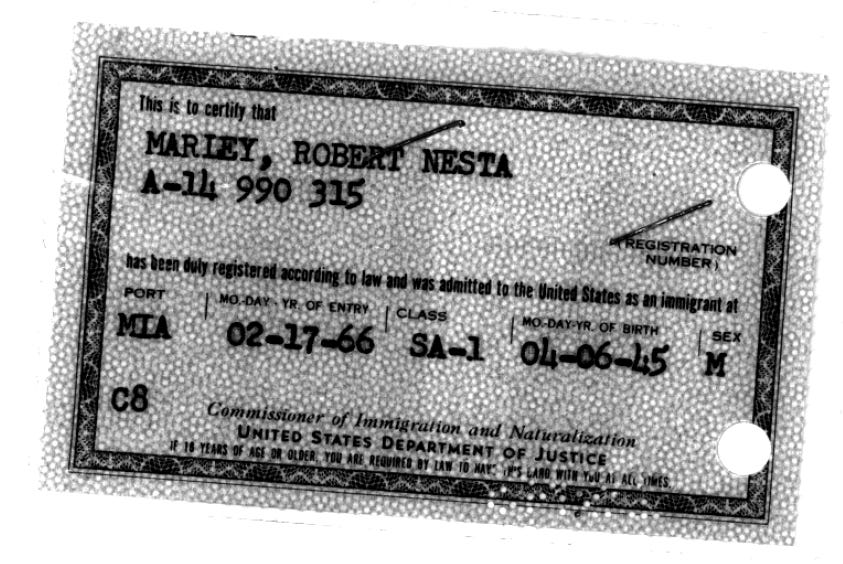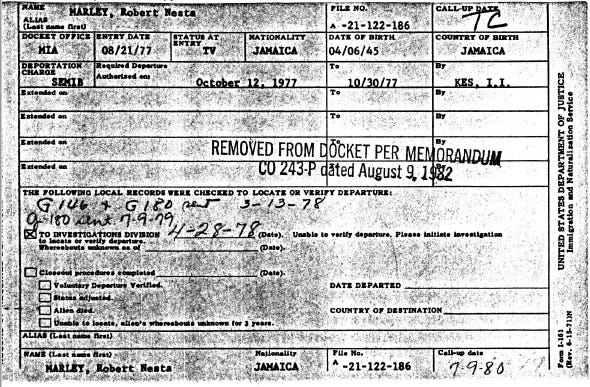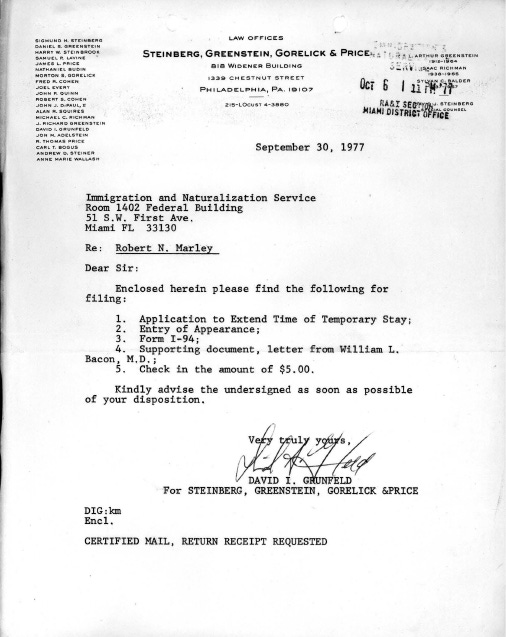A Question of F.B.I. Surveillance
Bob Marley was the tip of the iceberg for an activist dedicated to social justice.
Bob Marley died May 11, 1981. A month later, a man in California named Murv Glass filed a Freedom of Information Act request:

Conspiracy theories around Marley’s death have swirled for decades. Partly because conspiracies were always a part of Marley’s life and times. Here are just a few reasons that have fed the intrigue:
Jamaica 1970s: There was no secret that the C.I.A. was involved in attempts to destabilize the country to support opposition leader Edward Seaga of the Jamaican Labour Party in elections against prime minister Michael Manley (People’s National Party). The U.S. feared — and stop me if this smells familiar — that the small developing, recently independent nation with little military or strategic value other than its proximity to the southern coast of Florida would fall into communist leadership under continued PNP (i.e., social-democratic) rule and become “a second Cuba.” In its efforts, the C.I.A. furnished small arms to gangs employed by the conservative JLP in efforts to intimidate the PNP and its supporters — anything to cause chaos in the streets.
There was an assassination attempt on Bob Marley in 1976 at his home at 56 Hope Rd. two days prior to his appearance at Smile Jamaica, a free concert at National Heroes Park in Kingston. He was shot twice and his wife, Rita, was shot in the head. His manager, Don Taylor, was also shot multiple times, though no one died. The shooters were never caught or identified, and the long-prevailing suspicion is that the attempt was orchestrated by the JLP. Clearly too much for me to dig into here and others have turned this violent episode over every which way possible, from novelizations, like Marlon James’s “A Brief History of Seven Killings” to the Netflix “ReMastered” documentary series.
The F.B.I. had ongoing surveillance since at least the 1950s on Black activists, musicians and artists, anyone on a pulpit or in the public eye, from Martin Luther King to Nat King Cole — yes, the singer of “Chestnuts Roasting Over an Open Fire” — to jazz greats Max Roach and Charlie Mingus, among many, many others. According to Pacific Standard magazine, roots of the program stem from the FBI’s Counterintelligence Program (COINTELPRO) staged against Black extremists, Puerto Rican groups, the Socialist Workers Party, White Hate Groups, the “New Left.” (Again, more reporting on this lies elsewhere.)
Murv Glass was especially keen on this last reason.
In 1981, Murv Glass was a recent graduate of the University of California in Santa Barbara, where he was a writer for the student newspaper, The Daily Nexus, covering social justice and regularly appearing on the front page. One article from 1974 uncovered the misappropriation of financial assistance by the university that kept $116,000 worth of federal Education Opportunity Program funding from minority students. By the late-1970s, he was writing for Common Ground in Santa Barbara and in 1979 he reported on the Phoenix Program in Vietnam, the largest known C.I.A. assassination operation. A Phoenix agent interviewed by Glass at the time admitted that the covert operation sometimes targeted U.S. military personnel “regarded as security risks.” The agent, Timothy Dunn, said, “It came more reluctantly. though, Even though it was passed along. You kind of had the feeling it came from someplace else other than Division. Because in the military organization, Division was God.”
Clearly, I went waaay too deep in my Murv Glass research. You can’t blame me. He’s a fascinating character, a dogged reporter, an independent thinker and a driven man. And I’m sure we’ve only seen the tip of the iceberg. For now, though, this is enough to keep our story moving:
In 1981, Glass was a young, Black man. A writer for progressive publications, at least in his early years, he was consistent in his intentions: to defend the overlooked and underserved. He stood up against the establishment. And in pursuit of all these causes, he filed many FOIA requests and collected a wide range of documents relating to F.B.I. surveillance. His request to the DOJ for any and all records related to Bob Marley reveal his familiarity with the process and his persistence; the request passed through several offices over months until it was processed at DOJ offices in Philadelphia. He eventually received 95 pages, including Bob Marley’s original green card, which I have not seen before.


As I wrote in the first notesletter, there’s nothing in these documents that even hints at wiretaps, though six pages have been deleted. In terms of surveillance? Nothing obvious, though based on some of the communications between the INS and Marley and his team, which you’ll see in the document dump below, the government is on top of his movements during trips in 1966, 1977 and 1981.
You’ll see that Marley attempted to extend his visa in 1977. That was the year, a cancerous tumor was discovered under his right great toenail (yes, a medical term). His attorney filed for an extension and included a note from Marley’s doctor explaining the procedure to treat the tumor. But the application is denied. Which seems very odd. Hard to believe the U.S. was this obsessive over every visitor coming in and out of the country. Plus, Marley was an international star at that time. And he had cancer.



Returning to Murv Glass for a moment before closing this out. Shortly after Glass pulled the FOIA file for Bob Marley, he disappeared — at least, his digital footprint disappeared. If he published anything after the mid-1980s, it’s not online. All I know from a brief obit on Ancestry.com is that he died in 2011 in Willamette Valley, Oregon. What did he do for the last 30 years of his life? He was a reporter and activist, who dedicated himself to fight for social justice. And he published nothing after the mid-1980s? Hard to believe.
See you next week and be sure to tell your friends!












